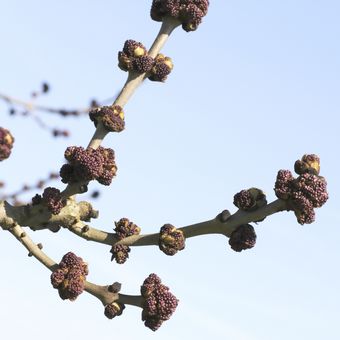Plantcompass
Ash (Fraxinus spp.)
General Information
Family: Olive family (Oleaceae)
Flowering period in Central Europe: Early spring to full spring
Months: 3–5
Allergy potential
Relevant allergenicity. Main allergen Fra e1. Sensitization often remains unrecognized.
Cross-reactions
Cross-reactivity to pollen of related olive family members (olive, lilac, forsythia, privet, jasmine) is possible.
Botanical Information
Distribution
Widely distributed across the Northern Hemisphere, with the southernmost occurrence in Indonesia and Costa Rica. Population declines in Europe due to ash dieback (fungal infestation). Habitats — Riparian forests, mixed forests, plains to montane regions.
Morphology
Habit – Tree or shrub. Foliage — Summer-green, leaves pinnately compound. Reproduction — Terminal or axillary, hermaphroditic, or unisexual inflorescences, characteristic winged fruit.
Commonly occurring species in Europe
Common ash or European ash (Fraxinus excelsior).
Habit — Tree. Characteristic black to dark brown winter buds. Habitats — Riparian forests, d summer-green forests, light-demanding species, pioneer species, important forestry tree, commonly found in parks. Plains to mountainous regions (up to 1800 m). Flowering periods in Central Europe — March to April.
Manna ash or South European flowering ash (Fraxinus ornus).
Habit — Tree. Reproduction — Pleasantly scented, white, racemose inflorescences. Habitats — Warm-loving element in summer-green forests. Native to the Mediterranean region, Southern Carinthia, and South Tyrol. Forestry planted or used as ornamental or park tree in other parts of Austria. Flowering period in Central Europe — April to May.
Narrow-leaved ash (Fraxinus angustifolia).
Habit — Tree. Distribution — Native to Southern Europe, North Africa, and Western Asia. Northernmost natural occurrence in Central Europe in the floodplains of Leitha, March, and Danube rivers. Occasional as ornamental or park tree. Flowering period in Central Europe — March to April.


